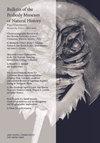Effects of Subterranean Limestone Sinks and Agricultural Development on Benthic Macroinvertebrate Communities of Canyon Creek (Wyoming)
IF 0.9
4区 哲学
Q2 BIODIVERSITY CONSERVATION
引用次数: 0
Abstract
Abstract This study documented and assessed benthic macroinvertebrate communities on a section of Canyon Creek through Tensleep Preserve in Washakie County, Wyoming, USA. Data for these communities are compared with previous samples collected downstream on agricultural land, as well as upstream and downstream from two subterranean, limestone sinks on the preserve. A shift from Plecoptera, Coleoptera, and Ephemeroptera to mainly Ephemeroptera to mainly Trichoptera was observed from the uppermost to the lowermost sites; Chironomidae and Diptera dominated the previously sampled section. High proportions of scrapers in sampled communities on the preserve beginning downstream of the upstream sink system suggested a prevalence of autochthonous detritus over allochthonous detritus at these sites. Macroinvertebrate community compositions and calculated metrics indicated high water quality for sites on the preserve and lower water quality for the agriculturally impacted sites. Ten taxa recorded from samples between the subterranean sinks were not recorded elsewhere. The mayfly Ameletus validus was abundant at the exit of the upper sink system at which the substrate was lined with irregular limestone slabs, and this taxon may be limited to the interior of this sink. Neothremma is identified as a feasible indicator taxon for climate change.地下石灰岩洼地和农业发展对Canyon Creek(怀俄明州)底栖大型无脊椎动物群落的影响
摘要:本研究记录并评估了美国怀俄明州瓦沙基县峡谷溪至Tensleep保护区的一段底栖大型无脊椎动物群落。这些群落的数据与之前在下游农业用地上收集的样本进行了比较,以及从保护区的两个地下石灰石水槽的上游和下游收集的样本。由上至下由翅翅目、鞘翅目、蜉蝣目为主向以蜉蝣目为主转变;手蛾科和双翅目占多数。从上游汇系统的下游开始,保护区取样群落中刮蚀物的比例很高,这表明在这些地点,原生碎屑比外来碎屑普遍存在。大型无脊椎动物群落组成和计算指标表明,保护区内的水质较高,受农业影响的地点水质较低。从地下汇之间的样本中记录的10个分类群在其他地方没有记录。在基底为不规则石灰岩板的上汇系统出口处有大量的蜉蝣(Ameletus validus),该分类群可能仅限于该汇的内部。新风马是一种可行的气候变化指示分类。
本文章由计算机程序翻译,如有差异,请以英文原文为准。
求助全文
约1分钟内获得全文
求助全文
来源期刊

Bulletin of the Peabody Museum of Natural History
BIODIVERSITY CONSERVATION-ECOLOGY
CiteScore
2.40
自引率
0.00%
发文量
6
审稿时长
>12 weeks
期刊介绍:
The Bulletin of the Peabody Museum of Natural History publishes original research based on specimens, artifacts and related materials maintained in the collections of the Yale Peabody Museum of Natural History’s curatorial divisions. The Bulletin is published twice a year, in April and October.
 求助内容:
求助内容: 应助结果提醒方式:
应助结果提醒方式:


